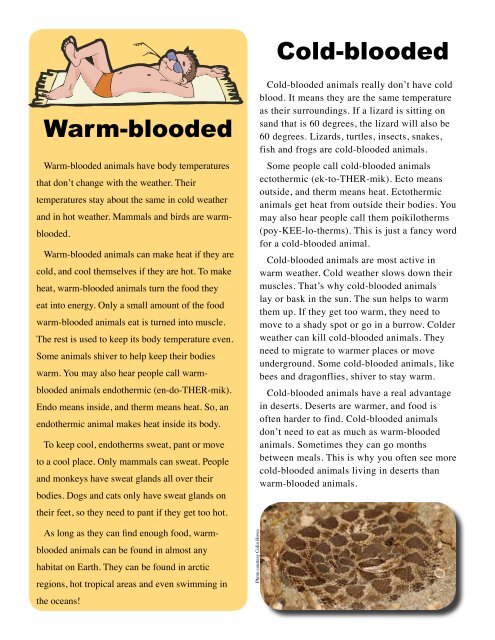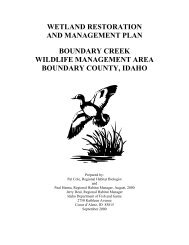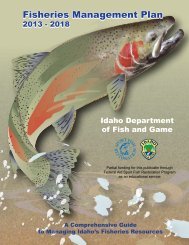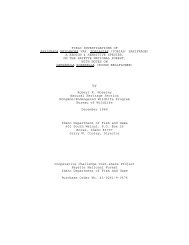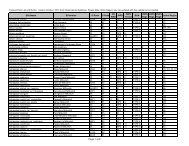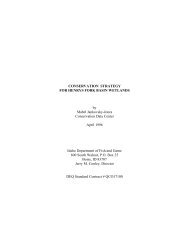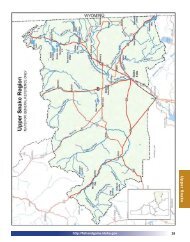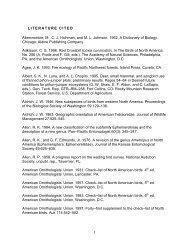May 2010 - Idaho Fish and Game
May 2010 - Idaho Fish and Game
May 2010 - Idaho Fish and Game
You also want an ePaper? Increase the reach of your titles
YUMPU automatically turns print PDFs into web optimized ePapers that Google loves.
Warm-blooded<br />
Warm-blooded animals have body temperatures<br />
that don’t change with the weather. Their<br />
temperatures stay about the same in cold weather<br />
<strong>and</strong> in hot weather. Mammals <strong>and</strong> birds are warm-<br />
blooded.<br />
Warm-blooded animals can make heat if they are<br />
cold, <strong>and</strong> cool themselves if they are hot. To make<br />
heat, warm-blooded animals turn the food they<br />
eat into energy. Only a small amount of the food<br />
warm-blooded animals eat is turned into muscle.<br />
The rest is used to keep its body temperature even.<br />
Some animals shiver to help keep their bodies<br />
warm. You may also hear people call warm-<br />
blooded animals endothermic (en-do-THER-mik).<br />
Endo means inside, <strong>and</strong> therm means heat. So, an<br />
endothermic animal makes heat inside its body.<br />
To keep cool, endotherms sweat, pant or move<br />
to a cool place. Only mammals can sweat. People<br />
<strong>and</strong> monkeys have sweat gl<strong>and</strong>s all over their<br />
bodies. Dogs <strong>and</strong> cats only have sweat gl<strong>and</strong>s on<br />
their feet, so they need to pant if they get too hot.<br />
As long as they can find enough food, warm-<br />
blooded animals can be found in almost any<br />
habitat on Earth. They can be found in arctic<br />
regions, hot tropical areas <strong>and</strong> even swimming in<br />
the oceans!<br />
Photo courtesy Colin Howe<br />
Cold-blooded<br />
Cold-blooded animals really don’t have cold<br />
blood. It means they are the same temperature<br />
as their surroundings. If a lizard is sitting on<br />
s<strong>and</strong> that is 60 degrees, the lizard will also be<br />
60 degrees. Lizards, turtles, insects, snakes,<br />
fish <strong>and</strong> frogs are cold-blooded animals.<br />
Some people call cold-blooded animals<br />
ectothermic (ek-to-THER-mik). Ecto means<br />
outside, <strong>and</strong> therm means heat. Ectothermic<br />
animals get heat from outside their bodies. You<br />
may also hear people call them poikilotherms<br />
(poy-KEE-lo-therms). This is just a fancy word<br />
for a cold-blooded animal.<br />
Cold-blooded animals are most active in<br />
warm weather. Cold weather slows down their<br />
muscles. That’s why cold-blooded animals<br />
lay or bask in the sun. The sun helps to warm<br />
them up. If they get too warm, they need to<br />
move to a shady spot or go in a burrow. Colder<br />
weather can kill cold-blooded animals. They<br />
need to migrate to warmer places or move<br />
underground. Some cold-blooded animals, like<br />
bees <strong>and</strong> dragonflies, shiver to stay warm.<br />
Cold-blooded animals have a real advantage<br />
in deserts. Deserts are warmer, <strong>and</strong> food is<br />
often harder to find. Cold-blooded animals<br />
don’t need to eat as much as warm-blooded<br />
animals. Sometimes they can go months<br />
between meals. This is why you often see more<br />
cold-blooded animals living in deserts than<br />
warm-blooded animals.


